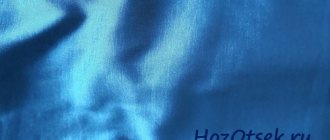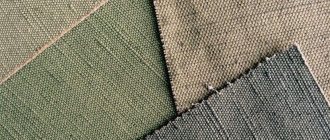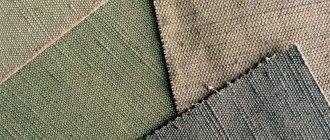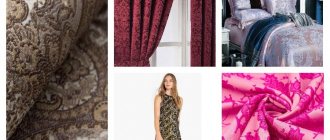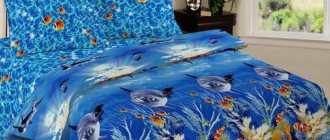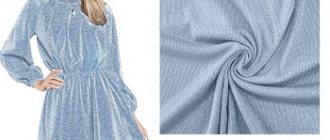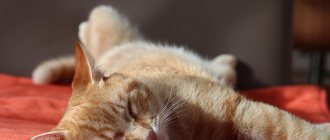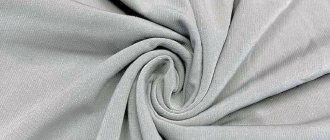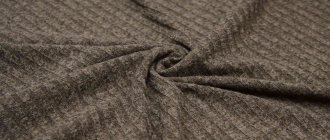Satin fabric is the name given to dense silk or semi-silk fabric, which has been known to mankind since ancient times. These fabrics are distinguished by a special, almost invisible satin weave. Canvases created in this way have a smooth front surface with a characteristic shine. This property of the satin is achieved due to the fact that the weft comes out through five or six warp threads to the front side. However, if we are talking about double-sided satin, then the weaving method is slightly different: the weft is hidden by two warp threads in between. Satin varies in composition, but historically this fabric was created from silk raw materials. Therefore, not everyone could afford to purchase this luxurious canvas. Beautiful iridescent fabric is great for sewing holiday items that will make you feel as impressive as possible.
History of the atlas
The material was created more than two thousand years ago by Chinese masters. For a long time they kept secret the method of producing this silk fabric. Gradually, neighboring countries began to take possession of the secret. But the shortage of silk did not allow mass production.
For many centuries, satin fabric was considered a privilege of the upper class. The palaces of monarchs, nobles and clergy were decorated with it.
Only in the twentieth century did the material become available to everyone, thanks to the discovery of synthetics, which managed to replace expensive and rare Chinese material.
How to work with fabric?
Before cutting satin fabric, decating is necessary - it is important to process the fabric, including washing and ironing, which minimizes the likelihood of the fabric shrinking in the product. Any silk-based fabrics require special care. For example, the first wash of fabric should be done with a delicate detergent, preferably ordinary shampoo, which is gentle on natural fibers.
It is best to iron satin in the “silk” mode while the fabric is still slightly damp. Are you dealing with stretchy fabric? So, use an ironing iron so that the iron does not stretch the fabric.
Before cutting satin materials, cover the table surface with a non-slip cloth. Make sure that the width of the table is enough to cover the entire width of the cut. This is the only way to perform longitudinal cutting.
Leave seam allowances, avoid using pins - they can cause punctures in the fabric. We recommend using weights instead of pins.
Use the thinnest needles available when sewing; it is better to get new needles that are sharp and without rough edges.
Often, when sewing satin parts on a machine, the effect of “settling” of the lower fabric appears, and such a product may turn out to be shorter in front than in the back. You can first baste the parts by hand and then machine stitch them. The problem is also solved by installing an upper conveyor for the sewing machine.
Variety of composition
Initially, the fabric was created from natural silk thread. Today such an atlas is considered the most expensive.
To save money and give the material greater elasticity and strength, natural or synthetic fibers are often added to silk:
- cotton;
- polyester;
- viscose;
- nylon;
- acetate.
Synthetic fibers can be used to create satin without using silk.
Satin weave - what is it?
Why is the outer side of satin so smooth, gliding and elegant? It's all about using a special weaving technology - satin weave of threads. How is it different from others? On the front side, the warp threads, which are located parallel along the edge of the future fabric, are “covered” by the weft thread, running at right angles to the warp. With satin weave, there are usually at least 4-5 warp threads overlapping one weft thread. It is this density of thread placement that makes the front side smooth and wear-resistant. The reverse side turns out matte, the skin perceives the touch of the material as a gentle touch.
Varieties of patterns
This fabric can be plain dyed or patterned.
The first option provides a plain, smooth structure.
In the second case, the following types of atlas are distinguished according to the method of execution of patterns:
- embroidered (the pattern is made by special machines on top of woven material);
- printed (paint is applied to the finished fabric);
- embossed (an engraved thermal roll is used);
- jacquard (natural method: new weaving is brought to the front side).
Texture
The satin comes in a variety of textures. There are plain-colored varieties with a single-color structure; jacquard, striking with their patterns. Materials with prints are usually divided into 2 groups.
By drawing method
The heterogeneity of patterned satin is due to different technologies. There are several types of fabric:
- Jacquard. On the outer surface there is a single-color or multi-colored pattern, which is obtained thanks to a special weave.
- Printed. In production, a special printer is used that applies dyes to the finished canvas.
- Embossed. The design is extruded using an engraved thermal machine.
- Embroidered. Previously, embroidery with colored threads was done by hand. Today embroidery machines are used for this.
Thermal printing uses durable, hypoallergenic, environmentally friendly inks. They do not fade, do not fade and are not capable of causing harm to health.
By type of ornament
The atlas is also distinguished by the style of the patterns:
- Maintenon. A distinctive feature is a pattern in the form of an imprint applied to a plain fabric. This name is in honor of the favorite of Louis XIV.
- Trianon. Its main feature is contrast. A light floral design (bouquets, clusters, leaves) is depicted on a dark background. On the light one there is a dark ornament. The name was given by the French village.
- Pompadour. The design is woven with gold or silver threads on a dark background. In this way, French weavers wanted to please Louis XV, glorifying his favorite.
Note: There is another complex pattern due to weaving technology. They call it Khan's silk. Threads of different colors form a pattern with smooth gradients, shimmering in different shades. In the West, Khan’s canvas is called “ikat”, which means “to unite”, “to bind”. This material is often used for sewing oriental national costumes.
Types of atlas
- Satin is a natural fabric. Made from a combination of cotton and silk.
- Crepe is a double-sided soft shiny material, somewhat rough. When creating it, tightly twisted transverse threads are used.
- Duchess. It has a high thread density and is rigid.
- Atlas Dupont. It also has high density. It has a strong shine.
- Taffeta. Lightweight but dense material. It has a characteristic shimmer.
- Russian atlas. Made from raw silk with finely woven threads.
- Antique has a textured look. It is produced by alternating thick and thin sections with threads as weft.
- Stretch. Lycra is used to create this fabric. Therefore, it practically does not wrinkle and fits well to the figure.
- Crash is a shiny crinkled fabric.
Varieties of atlas according to the type of drawing
Satin looks great on its own, due to its amazing shiny surface and “sliding” texture, but often this fabric is made even more refined using different decorative methods.
- Embroidery - it is performed on a ready-made satin fabric (it acts as a background), using an embroidery machine.
- Thermal embossing is a three-dimensional visual effect that requires a hot rolling roller with a pattern.
- Printing a pattern is the transfer of a colored “picture” or pattern onto the surface of a fabric using a special printing press, resulting in a printed satin.
- Jacquard - in this case, the pattern is applied to the surface of the fabric during the production process of the material, because jacquard patterns are made by special weaving of threads.
Application area
The atlas is often used to create:
- festive and weekend wear (evening and wedding dresses, men's suits);
- children's and women's underwear, men's nightgowns;
- casual clothes (blouses, skirts);
- linings for coats, fur coats and raincoats;
- home textiles (bed linen, curtains and curtains);
- accessories and decorations (umbrellas, gloves, hats, ties, bows).
Curtain satin is placed in a separate category. It is highly durable.
Shoe satin is used when sewing pointe shoes.
How the material is produced
To obtain satin, satin or satin weave is used. The principle is that most of the warp threads are released to the outside, overlapping the weft threads. This results in a material that is shiny and smooth on one side and matte, slightly rough on the other.
A beautiful double-sided satin, glossy on both sides, is created by using warp threads from two bundles, with the weft structure placed between them. Weaving provides decorativeness and shine to fabrics made from mixed fibers. The warp remains made of silk threads, and synthetic or cotton are used for the weft.
What's in it
The raw material for the first samples of fabric was natural silk thread. This material is considered expensive and elite. It is pleasant, soft and comfortable to wear. It has thermoregulation and looks impressive.
To mass produce and reduce the cost of fabric, other fibers of natural, artificial and synthetic origin began to be added. This was reflected in the properties of the material - it became more durable and elastic.
Modern satin is produced with the following additives:
- Cotton;
- viscose;
- acetate;
- polyester;
- elastane;
- nylon.
Including viscose or acetate in the composition allows you to maintain attractiveness and reduce cost. But this deteriorates the performance characteristics: the fabric becomes less durable, wrinkles more, and thermoregulation decreases.
Satin made from synthetic threads is considered universal and practical. The completely synthetic base allows the fabric to be produced without the use of silk. It is worth noting the stretch satin, which is easy to sew and does not need to be adjusted. The cut details are well connected using an American or French seam. However, synthetics have little breathability and hygroscopicity, which makes wearing in hot weather uncomfortable.
Pros of fabric
- Hypoallergenic. Dust does not accumulate on this material.
- Hygroscopicity. All types of this fabric tend to allow moisture to pass through and dry quickly after washing.
- Antistatic. Clothing made from this material does not accumulate static electricity.
- Strength. Crepe and curtain satin are especially durable.
- Long service life. This property is guaranteed with proper care of the products.
- Opacity.
- Satin can be draped. This advantage is often used in decorating clothes and rooms.
Properties and characteristics
Atlas gained popularity not only due to its elegant appearance. It has earned respect for its quality characteristics, including:
- High density. This provides mechanical tensile strength. It is not easy to tear fabric.
- Hygroscopicity. The fabric absorbs moisture well while remaining dry.
- Antistatic. Not electrified. During operation it does not require the use of antistatic agents.
- Hypoallergenic. Does not cause skin irritation.
All these properties brought the shiny, smooth canvas its well-deserved fame.
Care instructions
Things made from this fabric require attention. They should be cared for according to the instructions on the label.
General recommendations:
- It is better to wash by hand, after soaking in cool water.
- Do not rub or twist the fabric when washing.
- It is recommended to use mild detergents.
- Machine washable at minimum temperature, without spinning.
- Some satin items can only be dry cleaned (for example, fabrics with added acetate).
- Machine drying is prohibited.
- Dry horizontally on a dry towel.
- You can iron at low temperature from the reverse side through a protective cloth.
- It is advisable to store satin items in special cases in a dry and cool place.
Flaws
They exist too. Among the main ones:
- Tendency to shrink when exposed to high temperatures.
- When adding silk acetate, items may stretch.
- Inconvenience at work. Cutting material is difficult without the appropriate skills. It's slippery and heavy.
- Flowability. If the product breaks, it is difficult to repair.
Note: Some types of satin are heavy. Due to their heaviness, they require a special approach to operation.
Customer Reviews
Based on customer reviews, we can conclude that the best thing, of course, is natural satin. But this does not mean that synthetic or mixed fabrics are not worth buying.
Lyubov, seamstress at home: I often sew school costumes for various performances from inexpensive synthetic satin. The outfits are bright and serve the school for many years.
Anna, fashion designer: in our salon-atelier we often sew chic wedding dresses combining several types of satin. Often this is a dense, heavy material as the base of the entire dress, and light taffeta or crush as the upper airy layers.
Olga: As a public person who often performs at concerts, I have to change outfits often. Satin dresses of different colors and cuts are my thing. They look elegant, aesthetically pleasing, and are inexpensive.
What can be sewn from satin
You can sew any product you like from the fabric, from underwear to a wedding dress.
The main thing is to comply with 3 rules:
- Choose the type of fabric suitable for the future product.
- Take your measurements accurately.
- If you don't have much experience sewing with satin fabric, start working with simple things without complex styles.
Production Features
The fabric is made using two types of weave (satin or satin). The method consists of releasing the main weft threads onto the front part, through five or more warp threads. The material is endowed with a smooth and shiny effect on one side and matte on the other. The double-sided satin fabric is completely smooth due to the use of sets of warp fibers from two bundles.
The most expensive fabric is made from natural silk fibers. With the discovery of synthetic components, production has become widespread, so you can purchase satin freely, choosing any color scheme and texture.
What standards are used in production?
The production of the atlas is based on GOSTs 11209-85 and 20236-87. They describe both sanitary instructions and restrictions, as well as technical standards that must be taken into account in the production of the atlas.
Reaper
What is known about the fabric header? What is its composition and properties?
more details
Guipure
Lightness and delicacy: a complete overview of the properties of guipure fabric
more details
When producing satin fabrics, the following indicators are taken into account:
- Hygroscopicity (not less than 12).
- The degree of paint fastness (depending on the purpose of the fabric - ordinary/durable/extra durable).
- Content of free formaldehyde (children's fabric - up to 20, linen - up to 75, textile, dress - up to 300).
- Change in size after wet processing (no more than 2-5%).
- The increase in size of the material after washing or exposure to moisture is allowed up to 1.5%.
The raw materials used for production must be safe and meet the requirements of sanitary and epidemiological commissions and be certified.
History and manufacturing features
Wedding dresses are made from satin.
It is believed that satin was invented thousands of years ago in China. The manufacturing secret was strictly guarded and for a long time the material reached Europe only through Arab countries in the form of a curiosity. In the 15th century, the atlas appeared in Russia. Craftsmen made elegant clothes, hats and ribbons to trim dresses and decorate braids.
High-quality thick satin is not currently considered an economy-class fabric, but the Silk Road has long lost its status as its only source. The material is produced in textile factories, and you can buy it freely by choosing the appropriate color and texture.
The special shine of the fabric is obtained thanks to a special weaving technology. Satin weave consists of warp and weft threads (horizontal transverse weaving lines). The warp thread often extends onto the face of the fabric, wrapping around five or more weft threads.
Satin weave should not be confused with satin weave
There are the following patterns of thread overlap (warp/weft):
- five/two;
- seven/three;
- eight/three.
Thanks to this method, the canvas turns out shiny and smooth. Satin weave is often confused with satin weave. Indeed, in two types of weaving, one of the threads protrudes strongly into the face and forms a characteristic smoothness. However, satin is a weft weave. That is, one warp thread on the face, two on the wrong side - overlapped by the weft. The drawing turns out horizontal. Satin weaving forms a vertical pattern, here it is the other way around - the warp overlaps the weft.
The texture of the fabric can be:
- smooth;
- patterned.
According to the method of staining, the following types of atlas are distinguished:
- plain;
- maintenon - a pattern or ornament resembling a print is visible on a plain canvas;
- trianon - a contrasting canvas with a dark pattern and a light field (or vice versa);
- pompadour - a golden woven pattern on a dark fabric.
Smooth satin
High quality satin is made from natural silk thread.
To make the fabric more affordable, cotton, viscose and synthetic fibers are used as weft. There is also a double-sided satin, where the weft holds two warps together.
Where did the atlas come from?
An amazing way of weaving silk threads, which explains the luxurious and expensive appearance of the material, was invented by Chinese craftsmen more than 2 thousand years ago. For many centuries it was kept a deep secret, and the shining fabric was delivered along the Great Silk Road, was incredibly expensive and adorned only royal palaces and the most noble and wealthy persons.
In Russia, the material has been known since the 15th century. In the 18th century, satin clothes were held in high esteem at the court of Catherine II. With the development of silk weaving in our country, multi-colored shiny ribbons began to decorate the headdresses of urban fashionistas and the braids of young rural ladies.
How to explain shine and smoothness
The exceptional smoothness of the material is explained by the special, satin weaving of the threads, when most of the warp threads come out on the front side, in which the weft threads are inconspicuously included. This method produces a one-sided fabric, with a shiny front side and a matte, rough back. Products made from silk are classified as so-called count satin, or tuxedo satin.
The peculiarity of weaving allows you to create mixed fabrics that are equally decorative, but cheaper. They use silk threads as a warp, and cotton or synthetic ones for the weft.
Today, polyesters, acetate, nylon or viscose fibers are also used to make shiny material.
Modern production has created a technology for simultaneous use of two sets of warp threads with a weft mechanism placed between them. In this case, double-sided satin fabrics are produced that are equally gorgeous both from the front and from the back.
Advantages and disadvantages of satin fabric
The advantages of woven fabric include:
- The material retains its appearance well and does not fade in the sun. With proper care, it retains its shine for quite a long time.
- The natural fibers in the composition are highly breathable and allow the skin to breathe.
- Satin fabric does not accumulate dust and is hypoallergenic.
- Multifunctionality and versatility - suitable for sewing products for the home and all family members.
- Natural silk has healing properties, so sleeping on such bedding is even good for your health.
The disadvantages of the material include:
- The fabric is heavy, resulting in heavy products (this is especially true if your satin material is intended for curtains).
- It often shrinks when washing, so it is not recommended to abuse this method of cleaning products. In some cases, experts advise dry cleaning.
